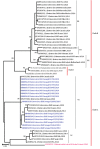Low Circulation of Subclade A1 Enterovirus D68 Strains in Senegal during 2014 North America Outbreak
- PMID: 31211670
- PMCID: PMC6590772
- DOI: 10.3201/eid2507.181441
Low Circulation of Subclade A1 Enterovirus D68 Strains in Senegal during 2014 North America Outbreak
Abstract
To retrospectively investigate enterovirus D68 circulation in Senegal during the 2014 US outbreak, we retrieved specimens from 708 persons, mostly children, who had acute respiratory symptoms during September-December 2014. Enterovirus D68 was detected in 14 children (2.1%); most cases occurred in October. Phylogenetic analysis revealed that all strains clustered within subclade A1.
Keywords: ARI; EV-D68; ILI; SARI; Senegal; enterovirus; outbreak; respiratory infections; surveillance; viruses.
Figures


References
-
- Midgley CM, Watson JT, Nix WA, Curns AT, Rogers SL, Brown BA, et al.; EV-D68 Working Group. Severe respiratory illness associated with a nationwide outbreak of enterovirus D68 in the USA (2014): a descriptive epidemiological investigation. Lancet Respir Med. 2015;3:879–87. 10.1016/S2213-2600(15)00335-5 - DOI - PMC - PubMed
-
- Vazquez-Perez JA, Ramirez-Gonzalez JE, Moreno-Valencia Y, Hernandez-Hernandez VA, Romero-Espinoza JA, Castillejos-Lopez M, et al. EV-D68 infection in children with asthma exacerbation and pneumonia in Mexico City during 2014 autumn. Influenza Other Respir Viruses. 2016;10:154–60. 10.1111/irv.12384 - DOI - PMC - PubMed
Publication types
MeSH terms
Substances
LinkOut - more resources
Full Text Sources

